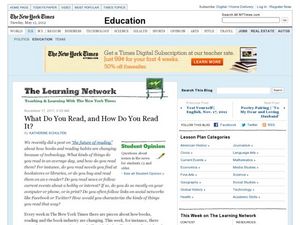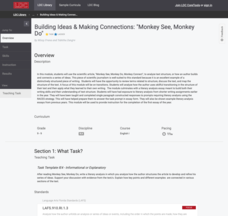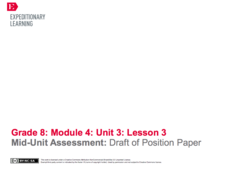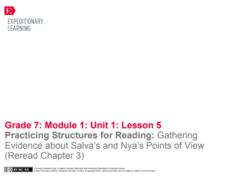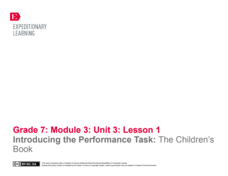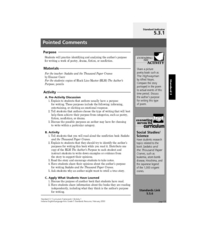Curated OER
Student Opinion: What Do You Read, and How Do You Read It?
Stimulate discussion with this brief article and series of questions related to reading habits. This resource, from the New York Times' The Learning Network, asks learners to comment on their own reading habits. You could have your class...
Curated OER
Student Opinion: When Did You Have a Great Conversation?
Conduct a classroom conversation about communication using this resource as a jumping-off point. For this The Learning Network activity, learners read an excerpt from The New York Times opinion piece, "The Flight From Conversation," and...
Texas Center for Learning Disabilities
Chapter 6 Teacher Guide and Student Log
Following routines established in previous lessons in the unit, study teams make and verify predictions about what will occur in "The Band," Chapter 6 of Tony Johnston's Any Small Goodness: A Novel of the Barrio. In addition, class...
Texas Center for Learning Disabilities
Chapter 9 Teacher Guide and Student Log
Intended to be used with the last chapter of Tony Johnston's Any Small Goodness: A Novel of the Barrio, this packet of intervention materials is designed to improve the reading comprehension of learners with special needs.
American Psychological Association
Top 20 Principles from Psychology for PreK–12 Creative, Talented, and Gifted Students’ Teaching and Learning
Who knew getting a better grasp on learning and psychology requires understanding only 20 principles? The resource, especially ideal for high school Psychology, discusses 20 important principles that debunk common myths and provide...
Khan Academy
Project: Bookshelf
Start your own virtual library with this JavaScript programming project. Create arrays of book objects, and fill the shelves with different books, different colors, titles, authors, etc. Let coders create their own unique display.
Harper Collins
Ramona Activity Booklet reading comprehension
Add a some variety to a reading of Beverly Cleary's Ramona series with this collection of fun worksheets and activities. From a basic reading comprehension crossword puzzle to a quiz that determines which character students are most...
McGraw Hill
Study Guide for Tuck Everlasting
Tuck Everlasting by Natalie Babbitt is a classic novel that readers have enjoyed for years. Resources within the study guide such as discussion and guided reading questions, extension activities, and graphic organizers aid comprehension...
College Board
1999 AP® English Literature and Composition Free-Response Questions
Have you ever felt like you are pulled into two directions? Some authors depict this feeling in their characters. Scholars choose a play or novel in which a character is pulled or influenced by two different directions and write essays...
College Board
2004 AP® English Literature and Composition Free-Response Questions Form B
Is there an art to dying? Scholars write essays describing how a death scene contributes to a novel or play. They also write essays analyzing poetic techniques an author uses and literary elements they see in a passage. Writers create...
College Board
2004 AP® English Literature and Composition Free-Response Questions
Have you ever felt left in the dark? Scholars write essays after analyzing two poems pertaining to night and darkness. Pupils also read a passage and write an essay discussing the author's depiction of characters. A third essay allows...
Literacy Design Collaborative
Building Ideas and Making Connections: "Monkey See, Monkey Do"
Reading a scientific article about cross-species synchronization may sound like a yawner. But "Monkey See, Monkey Do" is a fascinating tale that just happens to be about yawning, within and across species. After a close reading, class...
Literacy Design Collaborative
In Pursuit of Happiness
What ideas and philosophies guided the Transcendentalist movement in America? Scholars explore the topic, reading texts by Ralph Waldo Emerson and Henry David Thoreau. Additionally, they write essays comparing the authors' structural...
EngageNY
Grade 10 ELA Module 4: Unit 3, Lesson 1
Is it better to be loved or feared? Using the resource, scholars explore Machiavelli's nonfiction text, The Prince, and examine the author's ideas about the role of leadership. Pupils also complete a Quick Write to analyze a central idea...
EngageNY
The Authorship of Shakespeare: “The Shakespeare Shakedown”
Pupils conduct a close reading of "The Shakespeare Shakedown" by Simon Schama, and identify evidence the author uses to support his claims. Finally, they discuss and answer text-dependent questions before completing a Quick Write about...
EngageNY
Analyzing Experiences: Carlotta Walls
What was life like in the American South following the Civil War? Scholars watch a video that discusses the aftermath of the Civil War and the events during the Reconstruction Period. Additionally, they continue reading Carlotta Walls...
EngageNY
Mid-Unit Assessment: On-Demand Writing – Conflicting Interpretations of the 13th and 14th Amendments
The authors of the court's decision and the dissenting opinion on Plessy v. Ferguson disagreed on their interpretations of the Thirteenth and Fourteenth Amendments. Scholars set out to show how with an on-demand writing prompt. They...
EngageNY
Mid-Unit Assessment: Draft of Position Paper
What is the purpose of an introduction and conclusion? Using the resource, scholars review the model position paper from activity one and discuss the author's choices. Next, they draft their position papers' introductory and concluding...
EngageNY
Practicing Structures for Reading: Gathering Evidence about Salva’s and Nya’s Points of View (Reread Chapter 3)
How does an author develop and contrast character points of view in a work of literature? Using a graphic organizer, readers continue gathering evidence about character point of view from Linda Sue Park's A Long Walk to Water. Next,...
EngageNY
Introducing the Performance Task: The Children’s Book
Using a Venn diagram, class members generate similarities and differences between narratives and summaries. Next, pupils co-create an anchor chart to capture their thinking about how an author zooms in on a particular part of a story.
EngageNY
Using Effective Search Terms: Researching Screen Time
The proof is in the reading. Scholars read an article, "Attached to Technology and Paying the Price," and answer text-dependent questions. Next, they complete a Venn diagram to contrast two authors' use of evidence on the topic of screen...
EngageNY
Gathering Information about Water Management: Assessing and Reading Internet Sources, Day 3
Water is life! Using the informative resource, scholars first read two informational articles about water management in agriculture. Then, they use a Venn diagram to contrast the different types of evidence authors use to support a...
Curated OER
Pick Your Favorite Author
Students use the Internet to access information about their favorite author after reading a book by the author. They write a brief summary about the author.
Curated OER
Pointed Comments
Fifth graders analyze pieces of writing to identify the author's purpose of writing. In this writing lesson, 5th graders consider a variety of pieces of writing such as, poetry, drama, fiction, and non-fiction. Each student completes an...


